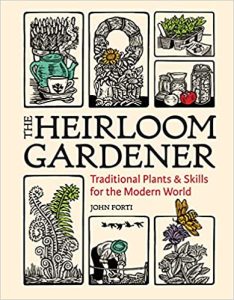Heirloom Gardening: The Old is New Again
By George Graine, Fairfax Master Gardener
“We don’t grow plants because they’re heirlooms, we grow plants because it worked well long enough that they become heirlooms.”
— Felder Rushing
 These days, we probably would not consider our daily life without many technical wonders that are readily available to us. Perhaps we tend to forget that the old ways of doing something are still worthwhile. You will find out why the new and the old are not in conflict in a new book by John Forti called “The Heirloom Gardener: Traditional Plants & Skills for the Modern World” (Timber Press, 2021). This book is a series of essays, arranged alphabetically, but not limited to plants so that you may be surprised to read so much about garden wisdom. Do not let the book title fool you because it is far from a stodgy text you might have found in your Granny’s attic. Forti does not discuss antiques but rather he notes that “. . . heirlooms are artifacts of our life experience that beckon us to preserve them.”
These days, we probably would not consider our daily life without many technical wonders that are readily available to us. Perhaps we tend to forget that the old ways of doing something are still worthwhile. You will find out why the new and the old are not in conflict in a new book by John Forti called “The Heirloom Gardener: Traditional Plants & Skills for the Modern World” (Timber Press, 2021). This book is a series of essays, arranged alphabetically, but not limited to plants so that you may be surprised to read so much about garden wisdom. Do not let the book title fool you because it is far from a stodgy text you might have found in your Granny’s attic. Forti does not discuss antiques but rather he notes that “. . . heirlooms are artifacts of our life experience that beckon us to preserve them.”
Now take a few moments to consider the Earth because the Earth that was here in yesteryear is still here today. That means our connection to the Earth continues to provide us with the necessities of life. Moving on, just as many of us learned a variety of how-to skills and knowledges from parents and grand-parents, so, too, there is much that can be learned from elder horticultural gardeners. Forti says, “We are seeking artisanal goods in a throwaway world, healing from a scarred environment.” He waves a caution flag when he writes, “Our stewardship of the land and protection of our shared environment are at a crossroads.” Can you argue with that? Do not despair as “The Heirloom Gardener” book will show us the renaissance that is happening all around us. There is a way forward as long as we are able to remember the past and choose those heirloom (traditional) ways. Forti goes on to say, “. . . to adapt them to foster a more sustainable future.”
Note that each short essay, although based on many old ways, is updated by employing the most recent scientific and technological precepts and this should help to enhance your gardening experience. In other words, consider how old ways can be revised and made new again. We now have ways of incorporating past methods into a more efficient way to garden. The essays include an explanation of how historical gardeners went about their chores. You might wonder why this methodology is foreign to you. On the other hand, some methods have stood the test of time. How to have a successful experience regarding canning and preserving some foods is a good example. Forti’s writing shows us how to reconnect with nature using the word symbiosis, that is, when mutually beneficial is perhaps a more accurate term. He uses plants to tell a story and has an innate ability to capture their nuance in today’s world.
The alphabetical index noted earlier starts with the herb angelica and as you might expect, ends with zucchini. In addition to essays on many plants, Forti touches on underused garden remedies, organic growing practices, seasonality, ethnobotany, bio-diversity and so much more in his multi-purpose philosophical guide. The fact is that our mental health benefits from gardening go deeper than you might have imagined and beyond what you may have thought about gardening, Fortis claims that gardening is a craft that provides important and valuable information. He goes on to explain how plants, garden lore and timeless practices will keep us grounded (pardon the pun).
The author’s words and his wisdom are just the ticket to help us take a step backward from our go-go-go world. Enjoy the environment that we are able to create for ourselves as well as the benefits that we are able to derive from simple pleasures. In the introduction to the book, Fortis says, “Heirlooms hold the keys to the past, though their patina may have changed over time.” He also notes that his “. . . goal is not to live in the past but to be present and participate in the betterment of my corner of the world.” How is your corner? We all can learn something, many things from “The Heirloom Gardener.” This book explains and teaches us about many varied horticultural practices. Is it time to apply the tried-and-true methods to your modern life style?